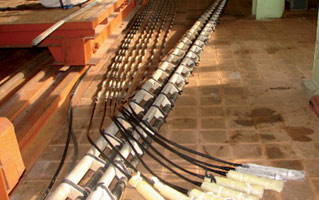Instruments and equipment
for vibro- and hydroacoustic measurements
 |
Hydroacoustic cable antennas
|
To provide the own IAP RAS research, primarily to study the vibration and acoustic characteristics of complex mechano-acoustic systems in the shipbuilding, aviation, and construction industries, the IAP RAS staff scientists develop and manufacture the measuring devices, namely, from the specialized sensors (piezoaccelerometers, hydrophones, and cable receiving and transmitting antennas), multiple-input systems (SIU-A/128-Ethernet), and high-power multiple PWM generators (UPWM-1000) to unique software for acoustic field sourse imaging.
The technical facilities ensure the formation of a coherent excitation field (up to 256 channels) and simultaneous measurement of acoustic pressure and vibration acceleration (up to 32 signal input units
SIU-A, from 32 to 128 channels in each) for an explored object size of the object of about hundreds of meters. Digital control of the measuring system, data collection, and synchronization of reception and excitation of signals are performed using the Ethernet interface. Dynamic control of the type and shape of the excitation, record, analysis, and real-time rendered display of the vibration and acoustic fields are implemented in a range of up to 20 kHz. Equipment of various configurations is employed for acoustic design, elaboration of aperture synthesis algorithms, creation of active suppression systems, and development and control of sonar equipment characteristics.
|
|
Analog signal input unit SIU-А / 128-Ethernet
|
32 channel transceiver with a power of 1.5 kV in each channel |
The sonar stations are provided with concept, schematics, and design documents for multichannel digital transceivers (A. S. Chashchin) with a fully digital formation of signals, control of the directional diagram of emission and reception, protection of the diagrams from rocking on the water, and other characteristics that are necessary for this type of facilities in a frequency range of up to 100 kHz. The distinctive features of the developed transceivers are a dynamic range of at least 115 dB, an expandable number of channels forming signals of an arbitrary shape in the PLIS (A. M. Sokov), and an efficiency of no less than 96% for the key power amplifier based on the PWM of the 2nd kind. The transceivers are designed for use in all-round, panoramic, and side view systems, acoustic imaging systems, vessel speed and trail meters, ultrasonic cleaning systems, and parametric sonars.
|
|
|
Signal generator
with PWM formation of 1 kV · А
|
Piezoaccelerometer with integral amplifier and path control
|
Key amplifier
of one channel
|





